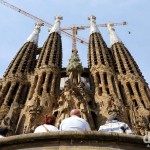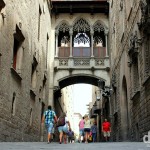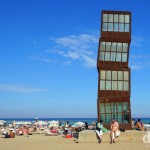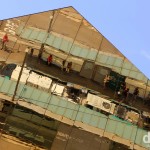Barcelona
Cosmopolitan, Stylish, Energetic & Home To Some Of The World’s Most Bizarre Architecture
Passeig Maritim, Barcelona, Spain. June 16, 2014
J ust like in Madrid before it, I’ve kept busy for the last three days looking around Barcelona, Spain’s second & most cosmopolitan city. A political hotbed & the capital of the Catalonia region of Spain, since the late 19th century this city has been breaking ground in art & architecture and today it is renowned worldwide for its unusual visual aesthetics; it’s visually a very different city to typically Spanish Madrid or anything one is likely to find in stereotypically Spanish Andalusia.
Good doggy bag advice today by @vueling en route from #Madrid to #Barcelona #Spain #travel #airlines #dmbtravel pic.twitter.com/3mNRW2Mevo
— davidMbyrne.com (@ByrneDavidM) June 16, 2014
Barcelona Architecture || Gaudi & Co., Modernisme & The Modernistas
Barcelona is a vast city of districts, each with their own architectural style. It is home to some of the world’s most unique architecture & whether you’re an architecture buff or not any visit to the city will result in ogling at some of the world’s most bizarre, somewhat confused looking buildings.
– www.barcelona-tourist-guide.com
A lot of the unique look of Barcelona can be attributed to a late 19th & early 20th century generation of inventive local architects, the most famous of which was Antoni Gaudi (1852-1926). By using Barcelona as a canvas & employing an adventurous combinations of materials like tiles, glass, brick, iron & steel, Gaudi & Co., a.k.a. the Modernistas, largely succeeded in creating their own Catalan architectural style, a local offshoot of the Europe-wide phenomenon of Art Nouveau & one that borrowed elements from virtually every other variety of architectural style – everything from Gothic to Islamic, Renaissance to Romanesque, Byzantine to baroque. I call it discombobulated Art Nouveau.
Read the whole post from my ambles around Barcelona or click here to access specific areas relating to what to see, of what I saw, in the city.
1 – Basílica i Temple Expiatori de la Sagrada Família
2 – L’Eixample (The Extension)
3 – Barri Gotic
4 – La Rambla
5 – Port Vell (Old Harbour) – Port de Barcelona & Barceloneta
6 – Camp Nou
The Gallery || Barcelona
- Passeig de Lluis Companys in Barcelona, Catalonia, Spain. June 17th, 2014.
- Gaudi’s Casa Batilo (right) & Casa Amatller (left) on Passeig de Gracia, Barcelona, Catalonia, Spain. June 17th, 2014.
- A section of the amazing Nativity facade of the UNESCO-listed Sagrada Familia in Barcelona, Catalonia, Spain. June 18th, 2014.
- Admiring the Nativity facade & towers of the eastern side of the Sagrada Familia in Barcelona, Catalonia, Spain. June 18th, 2014.
- A City Tour bus passing the Passion Facade of the Sagrada Família in Barcelona, Catalonia, Spain. June 17th, 2014.
- Passeig Maritim, Barcelona, Catalonia, Spain. June 16th, 2014.
- The Marina of Port Vell, Port de Barcelona, Barcelona, Catalonia, Spain. June 16th, 2014.
- Architectural detail on Calle del Bisbe Irurita in Barri Gotic, Barcelona, Catalonia, Spain. June 17th, 2014.
- Platja de la Barceloneta, Barcelona, Catalonia, Spain. June 16th, 2014.
- Camp Nou, Barcelona, Spain. June 18, 2014.
- On the platform of Diagonal Metro Station in Barcelona, Catalonia, Spain. June 18th, 2014.
- People on Spain’s most famous street, La Rambla in Barcelona, Catalonia, Spain. June 18th, 2014.
- A display in the museum of the Camp Nou Experience, Barcelona, Catalonia, Spain. June 18th, 2014.
- Fronting Europe’s largest sports stadium, Estadi Camp Nou in Barcelona, Catalonia, Spain. June 18th, 2014.
- Overhead tram stop reflections on Avenue Meridiana in Barcelona, Catalonia, Spain. June 17th, 2014.
- On the steps fronting the facada of La Catedral in Barri Gotic, Barcelona, Catalonia, Spain. June 16th, 2014.
- Detail of La Catedral in Barri Gotic, Barcelona, Catalonia, Spain. June 16th, 2014.
Basílica i Temple Expiatori de la Sagrada Família
The Roman Catholic Basílica i Temple Expiatori de la Sagrada Família is both Gaudi’s magnum opus & Spain’s most visited monument, as the queues to enter it will attest to. After 132+ years of construction it is still not finished, the ever-present cranes towering over the structure as iconic a sight as its 8 towers – upon completion there will be 12 towers in total signifying the 12 Apostles, the primary disciples of Jesus. Yes, there is method in all of this madness.

A City Tour bus passing the Passion Facade of the Basílica i Temple Expiatori de la Sagrada Família in Barcelona, Catalonia, Spain. June 17, 2014.
– Paul Goldberger, Pulitzer Prize-winning architectural critic commenting on the Sagrada Família.
Construction of Sagrada Família commenced in 1882. Gaudi wasn’t involved from the outset, only taking over the following year before going on to transform the structure with his own architectural and engineering style, one combining Gothic and curvilinear Art Nouveau forms. Gaudí devoted his last years to the project and at the time of his death in 1926 less than a quarter of the project was complete. Sagrada Família’s construction progressed slowly thereafter – it relied on private donations and was interrupted by the 1936-1939 Spanish Civil War – only to resume intermittent progress in the 1950s. Construction passed the midpoint in 2010 and with some of the project’s greatest challenges still remaining, the anticipated completion date has been set at 2026, the centenary of Gaudí’s death.
– Antoni Gaudí remarking on the extremely long construction period of the Sagrada Família.

Admiring the towers & the Nativity Façade of the Sagrada Família. Upon completion the Sagrada will have three grand façades: the Nativity Façade (to the east); the Passion Façade (to the west); and the Glory Façade (to the south & yet to be completed). Constructed between 1894 & 1930, the Nativity Façade was the first of the Sagrada’s three façades to be completed & the one bearing the most direct Gaudí influence. It & the Sagrada Família’s Crypt were inscribed on the UNESCO World Heritage list of protected sites in 1984, two of the 7 works by Gaudi in or near Barcelona collectively titled by UNESCO as ‘Works of Antoni Gaudi’. Barcelona, Catalonia, Spain. June 18, 2014.
– UNESCO commenting on the Works of Antoni Gaudi

Detail of the amazing UNESCO-listed Nativity Façade, the Sagrada’s artistic pinnacle. Mostly completed under Gaudi’s personal supervision, the façade is a tall three-part portal on the theme of Christ’s birth & childhood, one in which real people and animals were used by Gaudi as models for many of the façade sculptures. Barcelona, Catalonia, Spain. June 18, 2014.
– Rainer Zerbst, Art Critic, commenting on the Sagrada Família
L’Eixample (The Extension)
Want more Gaudi? Fine. The bulk, although not all, of the UNESCO-listed Works of Antoni Gaudi, including the Sagrada Família, are found in the affluent L’Eixample (the Extension) district of Barcelona, a spread-out grid of wide, straight boulevards that was the city’s 19th-century answer to the overcrowding of Barri Gotic, the central medieval part of the city (see below for more on Barri Gothic). L’Eixample’s main avenue, Passage de Gracia, is where you will find the more outlandish Modernist creations, with Gaudi’s Casa Batilo taking top billing.

The fairytale-esque façade of Gaudi’s Casa Batilo (right) is infused with bits of blue, mauve & green tile and is studded with wave-shaped window frames & balconies, all of which rises to an uneven blue-tiled roof interrupted by a solitary tower. Adjacent to Casa Batilo is Casa Amatller by Josep Puig i Cadafalch (left), another highly influential but less well-known member of the Catalan Modernistas. Passeig de Gracia, Barcelona, Catalonia, Spain. June 17, 2014.
Barri Gotic || Original Barcelona
There’s no Art Nouveau here. Barri Gotic, Barcelona’s Gothic Quarter, houses the bulk of the city’s ancient & medieval splendours. In total contrast to the wide boulevards of the L’Eixample district, Barri Gotic is a central district, a warren of narrow, winding streets, plazas, grand mansions and monuments. A remnant of the city’s golden age, many of the buildings here date from the 15th century or earlier, a time when thankfully Gaudi et al weren’t around to gaudy-up the Gothic stunners on show.

On the steps fronting the main northwest façade of La Catedral in Barri Gotic, the city’s most magnificent Gothic structure. The building dates from between 1298 and 1460 but the façade itself, based on a 1408 design, dates from as recent as the 1870s. It – the façade – looks great bathed in late afternoon/early evening sunlight when seen from the façade-fronting Placa de la Seu, probably the Barri Gotic’s most popular sit-and-watch-the-world-go-by public space. Barri Gotic, Barcelona, Catalonia, Spain. June 16, 2014.

Architectural detail on Calle del Bisbe Irurita in Barri Gotic, Barcelona, Catalonia, Spain. June 17, 2014.
La Rambla
You can’t avoid it, although you might want to once among the throngs. La Rambla, Spain’s most famous street and Barcelona’s tourist central, is a broad 1.2-kilometre-long pedestrianised boulevard flanked by narrow traffic lanes & lined with cafes, restaurants and any manner of attractions.

La Rambla’s 1.2 kilometre stretch, which is a densely packed mass of humanity most hours of the day, is divided into 5 sections, each with their own name & each boasting stalls selling everything from tours to flowers to the usual tourist tat. Opportunities to deviate off the main drag abound: Roman tombs; Barcelona’s most famous produce market, Mercat de la Boqueria; museums, including the Museu de I’Erotica; palm-shaded Placa Reial; & Barcelona’s grand opera house, Gran Teatre del Liceu, are all found on or just off La Rambla. La Rambla. Barcelona, Catalonia, Spain. June 18, 2014.
Port Vell (Old Harbour), Port de Barcelona & Barceloneta
La Rambla, somewhat conveniently, ends at Port Vell, Barcelona’s old waterfront harbour, an area of the city that was spruced up as part of a massive urban renewal program ahead of the 1992 Barcelona Olympics. Whereas in the past this was an no-go district of rundown warehouses & factories that caused public protests, today Port Vell is a rejuvenated focal point for city tourism boasting trendy cafes, bars, Europe’s largest aquarium, beaches, & numerous pedestrian promenades.

Boats in Port Vell’s marina with the distinctive tower of the Port Vell Aerial Tramway in the background. Opened in 1931, the tramway crosses Port Vell & offers great views of not only the Old Port area but also the city of Barcelona itself. Port Vell, Barcelona, Catalona, Spain. June 16, 2014.

The sculpture of L’Estel Ferit (The Wounded Shooting Star) on Platja de la Barceloneta (Barceloneta Beach), the city’s busiest & best-loved beach located in the district of the same name, a traditional Port Vell fishing district that also underwent wholesale redevelopment ahead of the 1992 Barcelona Olympics. The sculpture, referred to as simply ‘The Cubes’ by locals, consists of four twisted cubes stacked seemingly at random. According to Barcelona Tourism it signifies Barcelona’s penchant for ground-breaking art during the Olympic period while its symbolism is inextricably linked to the Barceloneta district’s past. Barcelona, Catalonia, Spain. June 16, 2014.

Taking a stroll on Passeig Maritim, a 1.25-kilometre-long promenade fronting Platja de la Barceloneta. The promenade ends at Port Olympic, a busy marina built to stage the sailing events at the 1992 Olympics. Clearly visible from the promenade is the 56-metre-long by 35-metre-high copper Peix (fish) sculpture by Frank Gehry, today not only one of the many symbols of post-Olympic Barcelona but also one of the city’s best-loved & iconic landmarks. Barcelona, Catalonia, Spain. June 16, 2014.
Camp Nou
The Camp Nou, the home of FC Barcelona, seats almost 100,000 (99,354 according to Wikipedia) making it the largest stadium in Europe. For that reason alone I paid it a visit. Messi (& Co.) were busy in Brazil with World Cup duties but his face, & that of his Barcelona teammates, was never too far away.

Fronting Europe’s largest sports stadium, Estadi Camp Nou in Barcelona, Catalonia, Spain. June 18, 2014.

Estadi Camp Nou, Barcelona, Spain. June 18, 2014.
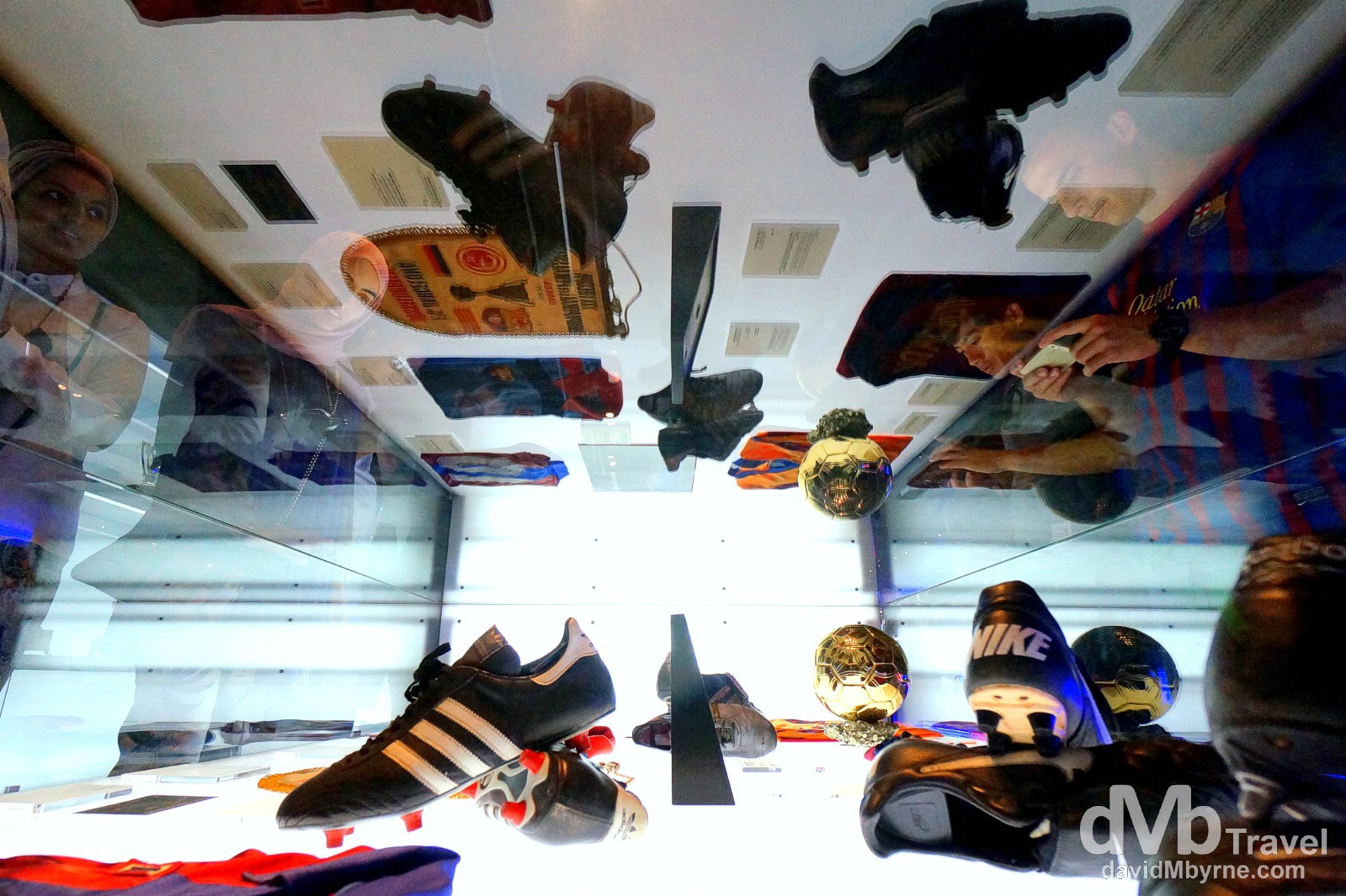
A display in the museum of the self-guided Camp Nou Experiencein Estadi Camp Nou, Barcelona, Catalonia, Spain. June 18, 2014.
Randoms
A few random captures from my time ambling around Barcelona.

Looking down Passeig de Lluis Companys towards the Arc de Triomf in Barcelona, Catalonia, Spain. June 17, 2014.

On the platform of Diagonal Metro Station in Barcelona, Catalonia, Spain. June 18, 2014.

Overhead tram stop reflections on the underside of a ceiling of a building on Avenue Meridiana in Barcelona, Catalonia, Spain. June 17, 2014.
Not quite #Barcelona but you're alright. #travel #Spain #dmbtravel pic.twitter.com/4uOftiLfrT
— davidMbyrne.com (@ByrneDavidM) June 18, 2014





